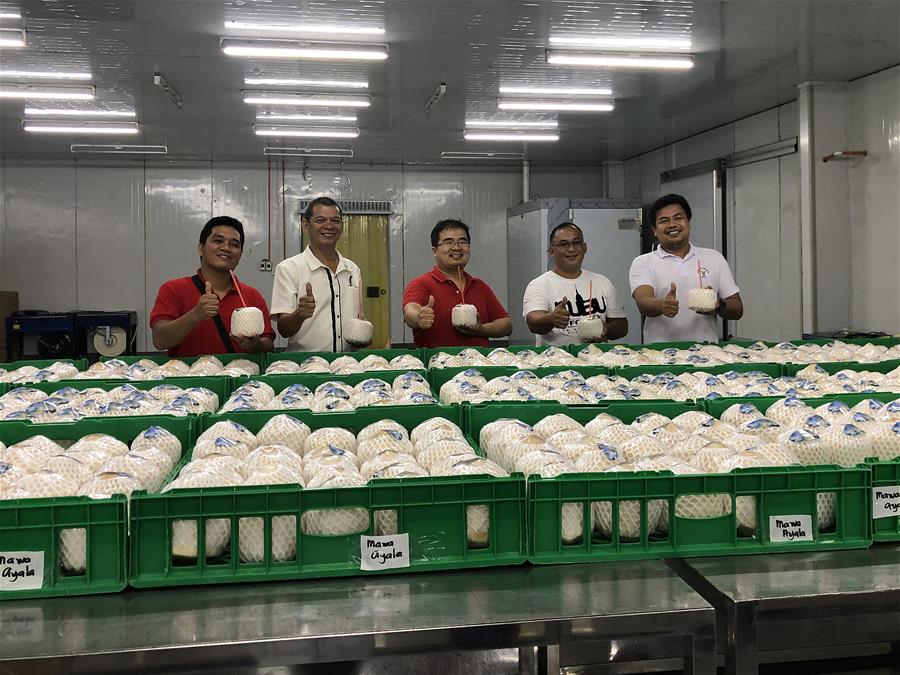 ?
?Workers pose for a photo with crates of coconut to be exported at a coconut plantation in Davao Province, the Philippines, Aug. 11, 2019. "I am very, very happy that China granted us access to their market," Philippine coconut exporter John Tan told Xinhua in an interview, adding that exporters and coconut farmers stand to gain from trade deal struck between Beijing and Manila. (Xinhua)
MANILA, Aug. 11 (Xinhua) -- John Tan has started shipping tons of aromatic young coconuts to China. Since the first shipment late last month, his company has so far shipped 108,000 pieces of young coconuts to the cities of Guangzhou and Xiamen, both in south China.
"I am very, very happy that China granted us access to their market," Philippine coconut exporter John Tan told Xinhua in an interview, adding that exporters and coconut farmers stand to gain from trade deal struck between Beijing and Manila.
Tan, president of Eng Seng Food Products, said the deal could breathe a new life into the Philippine coconut industry, an important pillar of Philippine agriculture.
Tan is upbeat about breaking into the Chinese market. "That is why I did not waste time when I heard about the news that China has opened its market to Philippine coconuts. I jumped at the opportunity, and started looking for a Chinese buyer," he said.
CHINA-PHILIPPINES TIES BEAR FRUIT
Indeed, trade agreements forged by the Philippine government and the Chinese government are bearing fruit.
"With President (Rodrigo) Duterte's independent foreign policy, the relationship of the Philippines and China has grown warmer, such benefits are now accruing to the trade and industry sector," Philippine Trade and Industry Secretary Ramon Lopez told Xinhua in a separate written interview.
Presently, Lopez said, "China's role has become very significant in our economy, given that they are now our top trading partner, our second foremost export market, and our number one import source."
While there is a perceived trend in protectionism, Lopez said the fact remains that with the continuous development of new technologies, fast paced interface of economies, and growing global market, international trade will remain a vital platform.
"Noting that in the conduct of trade, a stable and predictable business environment is preferred, the market will still adhere to rules based trading system," Lopez said.
Tan Qingsheng, the deputy chief of mission and minister counselor at the Chinese Embassy in the Philippines, said previously that bilateral trade volume between the Philippines and China in 2018 reached 55.7 billion U.S. dollars, with an 8.5 percent year-on-year increase.
"China is now the Philippines' top trading partner, the largest source of imports and the fourth largest export market," he told a Belt and Road Initiative (BRI) forum last month.
Over the past two years, Tan said China has imported more than 2 billion U.S. dollar tropical fruits from the Philippines.
Last year alone, he said China imported more than 1 million metric tons of bananas and became the No. 1 export market for Philippine bananas.
TREE OF LIFE
A recent report on the Philippine coconut industry says that coconut remains to be one of the most important crops and a major export of the Philippines. An estimated 25 million Filipinos directly or indirectly depend on the coconut industry for their livelihood.
However, it says that despite the continued boon of coconut exports, there has been no significant improvement in the coconut industry for the past years, adding that the development of the coconut industry would mean significant welfare improvement on the lives of millions of Filipino people.
"Coconut, also known as the 'tree of life,' is one of the most important crops in the Philippines. It is considered a major export, contributing 3.6 percent of the country's gross value-added (GVA) in agriculture, next to banana, corn and rice. Indeed, the country remains to be a top producer and exporter of coconut worldwide," says the report.
Former Agriculture Secretary Emmanuel Pinol said the Philippines is ranked No. 2 in the world with over 15 million metric tons of coconut produced every year from an area of about 3.5 million hectares.
Tan urged Filipino farmers to expand their aromatic variety of coconuts as there is a huge market in China due to its distinct taste and aroma.



